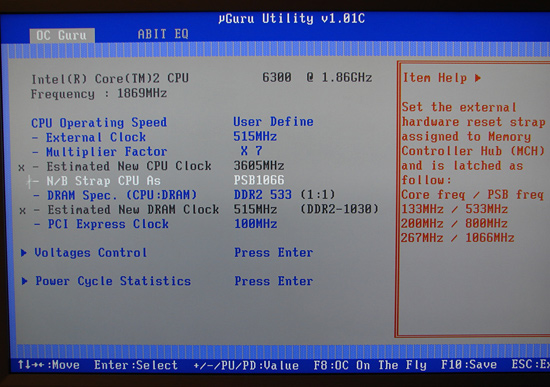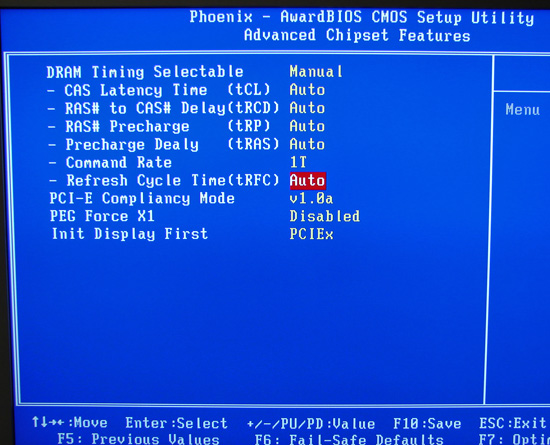Feature Set
abit has equipped this motherboard with a bevy of top end features and it is currently selling in the $219 range. The board features the Realtek ALC888 HD audio codec, Realtek RTL8810SC Gigabit Ethernet controller, dual e-SATA ports via the JMicron JMB363 chipset, and IEEE 1394 Firewire support. The accessory kit contains the basic SATA and IDE cables, external USB/Firewire bracket, and extensive documentation on the motherboard and µGuru functionality. However, abit did not include e-SATA cables and considering the cost of the kit we believe this in an omission.


The BIOS options for the AB9 QuadGT are fairly extensive for a motherboard in this sector, and of course the board features abit's excellent µGuru technology. The voltage options and availability of choices within each option will please the majority of enthusiasts. Besides memory voltage options up to 3.00V, the board also features the ability to change the command rate to 1T. In our initial testing we could not get 1T operation stable at DDR2-800 but were successful at DDR2-667 with a wide variety of Micron D9 based modules. However, we had trouble with several DDR2-667 modules based on Promos and Elpida memory ICs. The performance at DDR2-667 1T was equal to or up to 4% slower in several benchmarks when compared to DDR2-800 2T at the same memory latency timings. We believe abit still has significant tuning to complete to get 1T operating at DDR2-800 in a stable manner.
| abit AB9 QuadGT | |
| Market Segment: | Enthusiast Performance - $219.99 |
| CPU Interface: | Socket T (Socket 775) |
| CPU Support: | LGA775-based Pentium 4, Celeron D, Pentium D, Pentium EE, Core 2 Duo, Core 2 Extreme |
| Chipset: | Intel P965 + ICH8R |
| Bus Speeds: | 133 to 600 in 1MHz increments |
| Northbridge Strap: | CPU, 1066, 800, 533 |
| Memory Speeds: | SPD, 533, 667, 800 |
| PCIe Speeds: | 100 to 200 in 1MHz increments |
| PCI: | Fixed |
| Core Voltage: | Default, Base to 1.9250V in +.0100V increments |
| CPU Clock Multiplier: | Auto, 6x-11x in 1X increments if CPU is unlocked, Core 2 Duo downward unlocked |
| DRAM Voltage: | 1.800V to 3.000V in +.025V increments |
| DRAM- Ref Voltage: | +2%, 0%, -2%, -4% |
| DRAM Timing Control: | SPD, Manual, Auto or Manual for 6 DRAM Timing Options including Command Rate |
| MCH Voltage: | 1.25V to 1.70V in +.05V increments |
| CPU VTT Voltage: | 1.20V, 1.30V, 1.40V, 1.50V |
| ICH Voltage: | 1.05V, 1.10V, 1.15V, 1.20V |
| ICH IO Voltage: | 1.50V to 1.70V in +.05V increments |
| Memory Slots: | Four 240-pin DDR2 DIMM Slots Dual-Channel Configuration Regular Unbuffered Memory to 8GB Total |
| Expansion Slots: | 1 - PCIe x16 1 - PCIe x4 (x16 Physical) 1 - PCIe x1 2 - PCI Slot 2.3 |
| Onboard SATA/RAID: | 6 SATA 3Gbps Ports - RAID 0, 1, 5, 10 - Intel ICH8R 2 e-SATA 3Gbps Port - RAID 0, 1, JBOD - JMicron JMB363 |
| Onboard IDE: | 1 ATA133/100/66 Port (2 drives) - JMicron JMB363 |
| Onboard USB 2.0/IEEE-1394: | 10 USB 2.0 Ports - 4 I/O Panel - 6 via Headers IEEE 1394 - TI TSB43AB22A |
| Onboard LAN: | Realtek RTL8810SC - PCI Express Gigabit Controller |
| Onboard Audio: | Realtek ALC888 8-Channel HD Audio Codec |
| Power Connectors: | ATX 24-pin, 8-pin EATX 12V, 4-pin Molex |
| I/O Panel: | 1 x PS/2 Keyboard 1 x PS/2 Mouse 1 x CMOS Clear Switch 2 x S/PDIF Optical - In and Out 1 x IEEE 1394 Port 2 x e-SATA Port 1 x Audio Panel 1 x RJ45 4 x USB 2.0/1.1 |
| BIOS Revision: | Award 12/11/06 6A79LA1EC-10 |
abit has equipped this motherboard with a bevy of top end features and it is currently selling in the $219 range. The board features the Realtek ALC888 HD audio codec, Realtek RTL8810SC Gigabit Ethernet controller, dual e-SATA ports via the JMicron JMB363 chipset, and IEEE 1394 Firewire support. The accessory kit contains the basic SATA and IDE cables, external USB/Firewire bracket, and extensive documentation on the motherboard and µGuru functionality. However, abit did not include e-SATA cables and considering the cost of the kit we believe this in an omission.


The BIOS options for the AB9 QuadGT are fairly extensive for a motherboard in this sector, and of course the board features abit's excellent µGuru technology. The voltage options and availability of choices within each option will please the majority of enthusiasts. Besides memory voltage options up to 3.00V, the board also features the ability to change the command rate to 1T. In our initial testing we could not get 1T operation stable at DDR2-800 but were successful at DDR2-667 with a wide variety of Micron D9 based modules. However, we had trouble with several DDR2-667 modules based on Promos and Elpida memory ICs. The performance at DDR2-667 1T was equal to or up to 4% slower in several benchmarks when compared to DDR2-800 2T at the same memory latency timings. We believe abit still has significant tuning to complete to get 1T operating at DDR2-800 in a stable manner.










41 Comments
View All Comments
Operandi - Wednesday, January 24, 2007 - link
Excellent.Talcite - Monday, January 22, 2007 - link
Do you guys mean 'Final Impressions' on the last page of the article?Gary Key - Monday, January 22, 2007 - link
It was First Impressions, slip of the tongue until we get the next BIOS release. ;)mechBgon - Monday, January 22, 2007 - link
Hey Gary, I think you got a typo:You meant "noting," not "nothing," right?
JarredWalton - Monday, January 22, 2007 - link
That was my fault, and it's what happens when you edit at 3 AM (and use voice recognition). Anyway, it's fixed, thanks.sprockkets - Monday, January 22, 2007 - link
Intel has such a good processor, then messes up on the IDE. I would gladly make a computer around such a chip, but the nForce 6150 and AMD/Ati chipset is much more compelling, and since my customer needs IDE anyhow, AMD wins.MadAd - Tuesday, January 23, 2007 - link
Its taken all this time to get rid of the parallel port yet the much more used IDE (which should have the same kind of legacy lifespan) is out the door in a flash.If I had a tin foil hat id be shouting conspiracy theory and wondering which one of the storage majors paid Intel off to pull a stunt like that.
Stele - Monday, January 22, 2007 - link
Oh no, that misnomer strikes again... capacitors which use solid aluminium electrolyte are properly called "solid aluminium electrolyte" or at least "solid aluminium"... there are no "solid state" capacitors since, in electronic parlance "solid state" is traditionally used to describe circuits that do not use vacuum tubes (electron flows in solid materials - the semiconductors within ICs - rather than vacuum/empty spaces such as in tubes).
It's a minor point on the face of it, but Anandtech is well-respected throughout the IT community; hence a mistake or misconception could potentially reach and misinform a great deal of readers (and even writers) out there. :)
JarredWalton - Monday, January 22, 2007 - link
Changed - not all of us are electronics experts. Solid state or solid electrolyte - is there a difference to the laymen of the world? ;)Stele - Monday, January 22, 2007 - link
Oh no, no, didn't mean it in any negative way; I understand that, so was just contributing what little I can to help keep Anandtech at the top :P
You're probably quite right that the layman may not know the difference, and indeed they likely wouldn't care either way anyway. The ones we're worried about are those that are just entering the technical arena and/or are in their formative, learning stages... wouldn't want them to start on the wrong footing and spread the misstep when they in turn teach others ;)